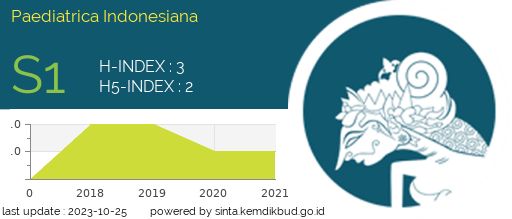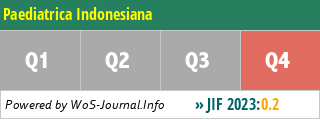Using complete blood count markers to predict febrile seizures
Abstract
Background The complete blood count test includes some markers of inflammation. Febrile seizures have been associated with inflammatory processes.
Objective To investigate for possible relationships between the occurrence of febrile seizures (FS) and complete blood count (CBC) parameters.
Methods Two hundred children aged 6-60 months presenting with fever at the Emergency Department between January 2022–August 2023 were included. These subjects were divided into a febrile seizures group (n = 100) and a control fever without seizures group (n =100). Demographic and complete blood count data were compared using logistic regression test.
Results The frequency of febrile seizures was significantly higher in younger children [mean age 23.89 (SD 15.88) months]. The febrile seizures group had lower lymphocyte counts but significantly higher white blood cell (WBC), neutrophils, platelets, neutrophil-to-lymphocyte ratio (NLR), and platelet-to-lymphocyte ratio (PLR) values than the control group. Multivariate analysis revealed that NLR (OR=0.84; P=0.001), PLR (OR=0.939; P=0.001), WBC (OR =0.773; P=0.001), neutrophil- platelet ratio (NPR) (OR=0.000; P=0.001), platelets (PLT) (OR=0.996; P=0.017), lymphocytes (OR=1.239; P=0.0001), and neutrophils (OR=1.047; P=0.022) had significant associations with febrile seizures while other parameters did not.
Conclusion Patients with febrile seizures had significantly higher levels of inflammatory markers, such as NLR, PLR, WBCs, PLTs, neutrophils, and NPR, and lower levels of lymphocytes than children with fever but no seizures, as determined by complete blood count findings.
References
Eilbert W, Chan C. Febrile seizures: A review. J Am Coll Emerg Physicians Open. 2022;3:e12769. DOI: https://doi.org/10.1002/emp2.12769
Aziza SN, Adimayanti E. Pengelolaan hipertermi pada anak dengan riwayat kejang demam sederhana di desa krajan banyubiru. J Holist Heal Sci. 2021;3:83-90. DOI: https://doi.org/10.35473/jhhs.v3i2.82
Byeon JH, Kim GH, Eun BL. Prevalence, incidence, and recurrence of febrile seizures in Korean children based on National Registry Data. J Clin Neurol. 2018;14:43–7. DOI: https://doi.org/10.3988/jcn.2018.14.1.43
Smith DK, Sadler KP, Benedum M. Febrile seizures: risks, evaluation, and prognosis. Am Fam Physician. 2019;99:445–50. PMID: 30932454
Maniu I, Costea R, Maniu G, Neamtu BM. Inflammatory biomarkers in febrile seizure: a comprehensive bibliometric, review and visualization analysis. Brain Sci. 2021;11:1077. DOI: https://doi.org/10.3390/brainsci11081077
Sawires R, Buttery J, Fahey M. A review of febrile seizures: recent advances in understanding of febrile seizure pathophysiology and commonly implicated viral triggers. Front Pediatr. 2022;9:801321. DOI: https://doi.org/10.3389/fped.2021.801321
Mosili P, Maikoo S, Mabandla M Vuyisile, Qulu L. The pathogenesis of fever-induced febrile seizures and its current state. Neuroscience Insights. 2020;15: 2633105520956973. DOI: https://doi.org/10.1177/2633105520956973
Hosseini S, Gharedaghi H, Hassannezhad S, Sadeghvand S, Maghari A, Dastgiri S, et al. The Impact of Neutrophil-Lymphocyte Ratio in Febrile Seizures: A Systematic Review and Meta-Analysis. Zeigler Johnson CM, editor. BioMed Res Int. 2022:1–14. DOI: https://doi.org/10.1155/2022/8472795
Hassan MA, Elsayeh AA, Hassan MAS. Relationship between the febrile seizures in children and complete blood count inflammatory indices. Sci J of Al-Azhar Med Fac, Girls. 2021;5:560-566. DOI: https://doi.org/10.4103/sjamf.sjamf_105_21
Yoldas MA, Hanci F, Dincel GK, Bekdas M. The predictive role of neutrophil-to-lymphocyte ratio and platelet-to-lymphocyte ratio in children with simple febrile seizures. Exp Biomed Res. 2021;4(3):198–205. DOI: https://doi.org/10.30714/j-ebr.2021370074
Ozdemir SI, Akca H, Kurt AN. Neutrophil-lymphocyte and platelet-lymphocyte ratios in febrile seizures. J Pediatr Emerg Intensive Care Med. 2022;9:158–61. DOI : https://doi.org/10.4274/cayd.galenos.2021.25483
Bolayir A. Evaluation of monocyte/lymphocyte, neutrophil/lymphocyte, and platelet/lymphocyte ratios in patients with temporal lobe epilepsy. Arch Epilepsy. 2022;28:29–34. DOI: https://doi.org/10.54614/ArchEpilepsy.2022.56933
Zahorec R. Neutrophil-to-lymphocyte ratio, past, present and future perspectives. Bratisl Lek Listy. 2021;122:474–88. DOI : https://doi.org/10.4149/BLL_2021_078
Buonacera A, Stancanelli B, Colaci M, Malatino L. Neutrophil to lymphocyte ratio: an emerging marker of the relationships between the immune system and diseases. Int J Mol Sci. 2022;23:3636. DOI: https://doi.org/10.3390/ijms23073636
Yigit Y, Yilmaz S, Akdogan A, Halhalli HC, Ozbek AE, Gencer EG. The role of neutrophil-lymphocyte ratio and red blood cell distribution width in the classification of febrile seizures. Eur Rev Med Pharmacol Sci. 2017;21:554–9. PMID: 28239812.
Goksugur S, Kabakus N, Bekdas M, Demircioglu F. Neutrophil-to-lymphocyte ratio and red blood cell distribution width is a practical predictor for differentiation of febrile seizure types. Eur Rev Med Pharmacol Sci. 2014;18:3380-5. PMID: 25491611.
Baran O. Assessment of neutrophil to lymphocyte and platelet to lymphocyte ratios in patients with temporal lobe epilepsy. J Turkish Epil Soc. 2019. DOI: https://doi.org/10.14744/epilepsi.2019.65902
Liu Z, Li X, Zhang M, Huang X, Bai J, Pan Z, et al. The role of mean platelet volume/platelet count ratio and neutrophil to lymphocyte ratio on the risk of febrile seizure. Sci Rep. 2018;8:15123. DOI: https://doi.org/10.1038/s41598-018-33373
Tang L, Chen JR. The predictive value of hemocytometry based on peripheral platelet-related parameters in identifying the causes of febrile seizures. J Inflamm Res. 2021;14:5381–92. DOI: https://doi.org/10.2147/JIR.S334165
Somaschini A, Cornara S, Demarchi A, Mirizzi AM, Fortuni F, Crimi G, et al. Neutrophil to platelet ratio: a novel prognostic biomarker in ST-elevation myocardial infarction patients undergoing primary percutaneous coronary intervention. Eur J Prev Cardio. 2020;27:2338-40. DOI: https://doi.org/0.1177/2047487319894103
He W, Ruan Y, Yuan C, Cheng Q, Cheng H, Zeng Y, et al. High neutrophil-to-platelet ratio is associated with hemorrhagic transformation in patients with acute ischemic stroke. Front Neurol. 2019;10:1310. DOI: https://doi.org/10.3389/fneur.2019.01310
Downloads
Published
How to Cite
Issue
Section
License
Copyright (c) 2025 Ufik Maulena, Muchammad Fahrul Udin

This work is licensed under a Creative Commons Attribution-NonCommercial-ShareAlike 4.0 International License.
Authors who publish with this journal agree to the following terms:
Authors retain copyright and grant the journal right of first publication with the work simultaneously licensed under a Creative Commons Attribution License that allows others to share the work with an acknowledgement of the work's authorship and initial publication in this journal.
Authors are able to enter into separate, additional contractual arrangements for the non-exclusive distribution of the journal's published version of the work (e.g., post it to an institutional repository or publish it in a book), with an acknowledgement of its initial publication in this journal.
Accepted 2025-04-09
Published 2025-04-25













